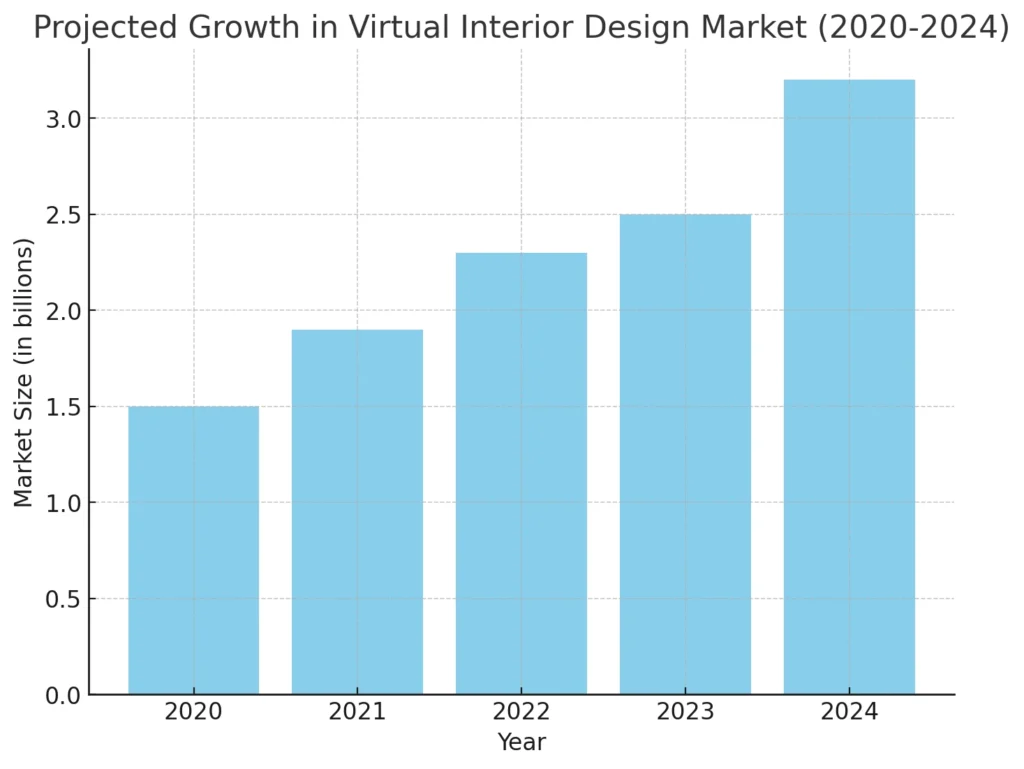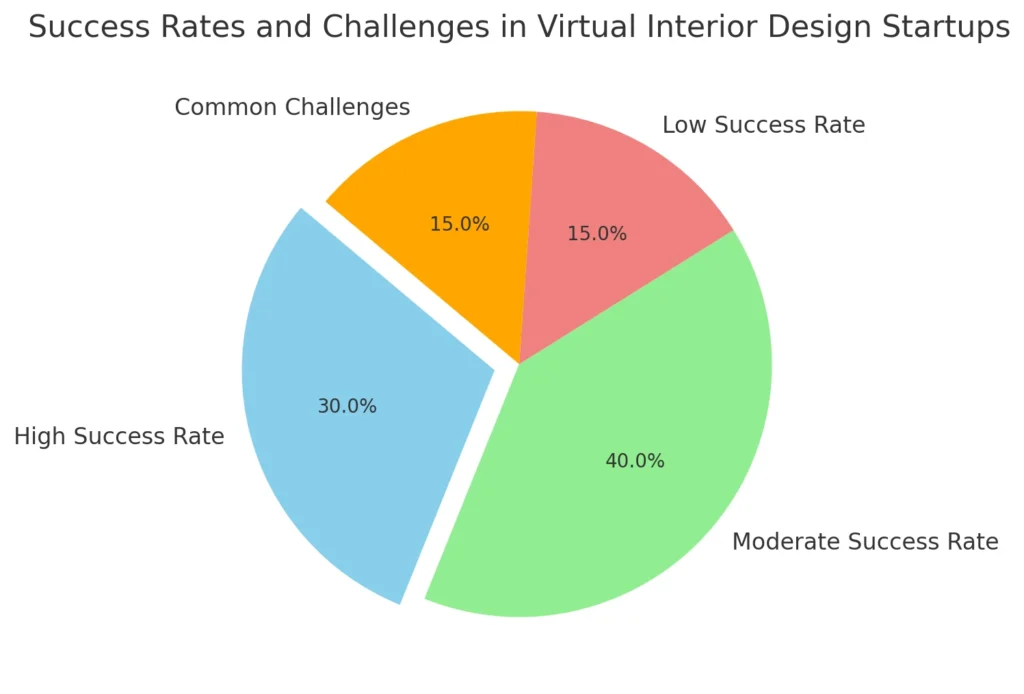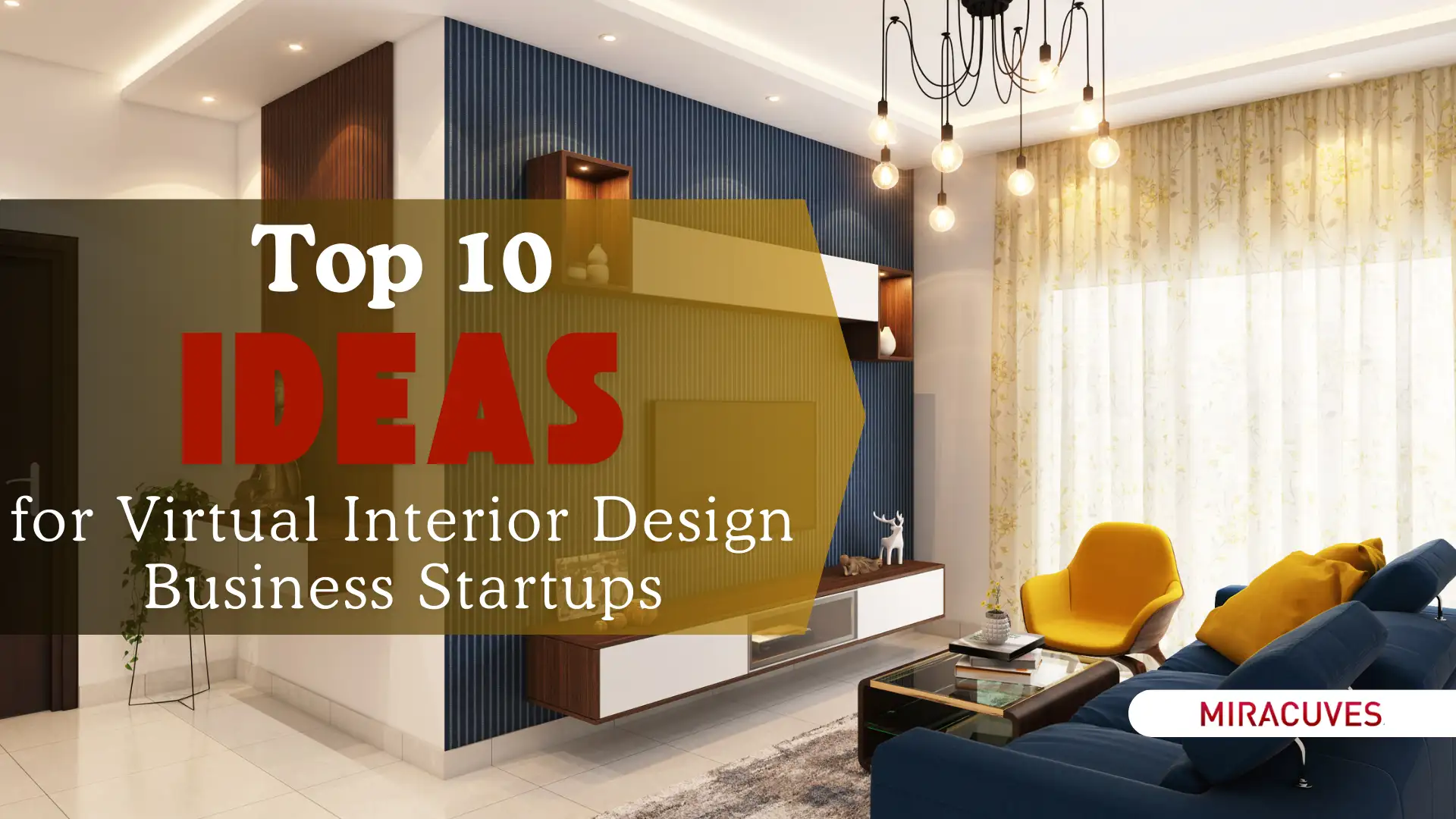In recent years, virtual interior design has transformed from a niche market to a booming industry, thanks to advances in technology and an increasing demand for flexible, remote-friendly services. As people spend more time in their homes, the desire to personalize and optimize living spaces has never been higher. With 3D modeling, virtual reality (VR), and augmented reality (AR) making it possible to visualize changes before they happen, virtual interior design is more accessible, affordable, and interactive than ever before. This industry appeals not only to homeowners but also to businesses seeking innovative, cost-effective design soluções.
In 2024, the virtual interior design market is expected to continue growing rapidly, driven by trends like sustainable design, digital accessibility, and remote work. For aspiring entrepreneurs, this presents an exciting opportunity to tap into a lucrative, evolving industry. Whether you’re passionate about design, have technical skills in visualization tools, or simply want to explore a creative business model, the virtual interior design space offers diverse pathways for startup success.
| Estatística | Dados |
|---|---|
| Tamanho do mercado global (2023) | $2.5 billion |
| Projected Market Size (2024) | $3.2 billion |
| Taxa de crescimento anual | 12% |
| Key Growth Driver | Increased demand for remote and flexible serviços de design |
| Popular Technologies | 3D Modeling, Virtual Reality (VR), Augmented Reality (AR) |
| Major Trends | Sustainable Design, Digital Accessibility, Personalized Home Spaces |
| Target Customer Segments | Homeowners, Remote Workers, Small Businesses, Commercial Spaces |
Why Choose Virtual Interior Design?

Virtual interior design is swiftly rising as a preferred choice for those looking to start a business in 2024, and it’s easy to see why. This industry offers a unique blend of creativity and technology, attracting both design enthusiasts and tech-savvy entrepreneurs. The flexibility of virtual interior design allows clients to receive tailored design solutions without the need for in-person visits, creating a more convenient and accessible service for today’s digital-driven world.
With more people working and living in spaces that demand functionality and personalization, the demand for innovative, adaptable design solutions is stronger than ever. Virtual design also supports sustainable practices by reducing the need for physical materials and allowing changes to be visualized digitally, which aligns with the growing emphasis on environmental responsibility. From small businesses seeking attractive office spaces to homeowners eager to create a serene environment, the market for virtual interior design spans a broad and diverse clientele.
For startups, virtual interior design offers several competitive advantages. Not only does it require a lower initial investment compared to traditional design services, but it also allows businesses to scale quickly. Entrepreneurs can offer services to clients around the world, breaking the geographical limitations of in-person design. Additionally, the integration of VR and AR technologies creates immersive experiences that traditional design consultations cannot match, making virtual design a modern and engaging solution.
Current Trends and Future Opportunities in Virtual Interior Design
The virtual interior design industry is evolving rapidly, driven by technological advancements and changing consumer preferences. As we move into 2024, several key trends are shaping the industry, opening new opportunities for startups to thrive.
One prominent trend is the integration of Augmented Reality (AR) and Virtual Reality (VR), allowing clients to experience immersive 3D walkthroughs of their redesigned spaces before any physical changes are made. These tools give clients a clear sense of space, scale, and style, enhancing decision-making and satisfaction. For new businesses, this technology offers an edge, enabling more interactive and engaging customer experiences.
Another rising trend is the emphasis on sustainable design. Consumers are increasingly looking for eco-friendly options that align with their values, from using virtual consultations to reduce travel emissions to recommending materials with low environmental impact. Virtual interior designers can capitalize on this trend by integrating sustainability into their offerings, from furniture choices to energy-efficient design recommendations.
Personalized design solutions are also in demand, as clients seek spaces that reflect their unique tastes and lifestyles. With AI-driven algorithms, virtual interior designers can offer tailored recommendations based on individual preferences, enhancing the level of customization in each project. This allows startups to differentiate themselves by offering high-quality, personalized services at a fraction of the traditional cost.
Finalmente, remote workspaces continue to be a hot topic, as businesses and individuals look to optimize their environments for productivity and comfort. Virtual interior design startups can seize this opportunity by specializing in home office designs and ergonomic layouts, catering to the growing remote workforce.
Unity’s page on augmented reality provides comprehensive information on AR technology, which can support readers’ understanding of how AR integrates into virtual interior design.
| Tendência/Tecnologia | Descrição | Impacto na Indústria |
|---|---|---|
| Realidade Aumentada (RA) | Enables clients to view design elements overlaid in their actual space through a mobile device. | Increases client engagement and aids in decision-making. |
| Realidade Virtual (RV) | Offers immersive 3D tours of redesigned spaces before any physical changes are made. | Provides an interactive, engaging experience, boosting satisfaction. |
| Inteligência artificial (AI) | Uses algorithms to provide personalized design recommendations based on client preferences. | Enhances customization and improves client satisfaction. |
| Sustainable Design | Focuses on eco-friendly materials and reducing carbon footprint in design practices. | Aligns with consumer demand for environmentally responsible choices. |
| Remote Workspace Design | Optimizes home office layouts for productivity and comfort. | Caters to the growing market of remote workers and home offices. |
Top 10 Ideas for Virtual Interior Design Business Startups
The virtual interior design industry offers a variety of profitable startup ideas that cater to different client needs and business models. Here are ten innovative ideas to consider if you’re looking to break into this field.
- 3D Room Visualization Services
- Por que: Clients want to see how their space will look before committing to changes.
- Requisitos de inicialização: Proficiency in 3D rendering software; a portfolio of sample designs.
- Mercado-alvo: Homeowners, property developers, and interior design firms.
- Custos estimados: Initial software and equipment investment, approximately $1,000 to $3,000.
- Virtual Design Consultation
- Por que: Provides affordable, accessible design advice for clients worldwide.
- Requisitos de inicialização: Strong design knowledge, reliable video conferencing tools.
- Mercado-alvo: DIY enthusiasts, renters, and small businesses.
- Custos estimados: Low initial investment, mostly marketing and platform setup.
- E-Design Packages
- Por que: Offers clients customized design packages that fit their budget and style.
- Requisitos de inicialização: Skills in digital design tools, ability to create templates.
- Mercado-alvo: Budget-conscious homeowners and first-time buyers.
- Custos estimados: Minimal, primarily design software and template creation.
- Home Office Design Services
- Por que: The demand for optimized home offices is increasing with remote work.
- Requisitos de inicialização: Knowledge of ergonomic and space-efficient design.
- Mercado-alvo: Remote workers, freelancers, and small business owners.
- Custos estimados: Low; focus on marketing and customer acquisition.
- Sustainable Interior Design Consultancy
- Por que: Growing awareness of eco-friendly design is driving demand.
- Requisitos de inicialização: Expertise in sustainable materials and practices.
- Mercado-alvo: Environmentally conscious clients and businesses.
- Custos estimados: Moderate; may involve certification in sustainable design.
- Real Estate Virtual Staging
- Por que: Virtually staged properties sell faster and attract more interest.
- Requisitos de inicialização: Proficiency in staging software, access to a design library.
- Mercado-alvo: Real estate agents and property managers.
- Custos estimados: Software and licensing fees, around $1,500 to $2,500.
- AR-Driven Shopping Assistance
- Por que: Allows clients to visualize furniture and decor items in their space before purchase.
- Requisitos de inicialização: AR platform access, partnerships with furniture retailers.
- Mercado-alvo: Homeowners and retail furniture clients.
- Custos estimados: Moderate; AR technology and integration expenses.
- Virtual Color Consultation
- Por que: Clients often struggle with color choices; this service offers professional guidance.
- Requisitos de inicialização: Knowledge of color theory, software for digital color matching.
- Mercado-alvo: Homeowners, office spaces, and hospitality businesses.
- Custos estimados: Low; mainly requires marketing and digital tools.
- Personalized Style Guides
- Por que: Provides clients with style recommendations that align with their tastes and lifestyles.
- Requisitos de inicialização: Design skills, ability to create digital style boards.
- Mercado-alvo: New homeowners and design novices.
- Custos estimados: Minimal; primarily design tools and online marketing.
- Space Planning and Layout Optimization
- Por que: Many clients need help making the most of their existing spaces.
- Requisitos de inicialização: Proficiency in layout design software, spatial awareness.
- Mercado-alvo: Small apartments, shared spaces, and offices.
- Custos estimados: Low to moderate, depending on software used.
BoxBrownie’s page on virtual staging services can help readers learn more about this specific service, aiding those interested in starting a virtual staging business.
| Ideia de negócio | Custo Inicial Estimado | Mercado Alvo | Potencial de lucro |
|---|---|---|---|
| 3D Room Visualization Services | $1,000 – $3,000 | Homeowners, property developers, firms | Alto |
| Virtual Design Consultation | Baixo | DIY enthusiasts, renters, small businesses | Moderado |
| E-Design Packages | Mínimo | Budget-conscious homeowners, first-time buyers | Moderado |
| Home Office Design Services | Baixo | Remote workers, freelancers, small business owners | Alto |
| Sustainable Interior Design Consultancy | Moderado | Eco-conscious clients and businesses | Alto |
| Real Estate Virtual Staging | $1,500 – $2,500 | Real estate agents, property managers | Alto |
| AR-Driven Shopping Assistance | Moderado | Homeowners, retail furniture clients | Alto |
| Virtual Color Consultation | Baixo | Homeowners, offices, hospitality spaces | Moderado |
| Personalized Style Guides | Mínimo | New homeowners, design novices | Moderado |
| Space Planning and Layout Optimization | Baixo a moderado | Small apartments, shared spaces, offices | Alto |
Exemplos do mundo real ou estudos de caso

To understand the real impact and potential of virtual interior design startups, let’s look at some key examples that illustrate success stories and challenges within the indústria. These case studies demonstrate the versatility of virtual interior design and the various approaches that startups can take.
- Virtual Staging for Real Estate
UM startup offering virtual staging services helped a real estate agency increase property viewings by 40%. By transforming empty rooms into stylish, fully furnished spaces, the agency attracted more buyers and reduced property listing times. This example highlights the high demand for virtual staging, especially in competitive real estate markets. - Remote Workspace Design for Corporate Clients
A virtual design firm specializing in remote office layouts partnered with a major tech company to create personalized work-from-home spaces for its employees. The service improved productivity and employee satisfaction by offering ergonomic and space-efficient setups. This case demonstrates the potential of virtual interior design in the corporate sector, catering to the growing remote work trend. - Sustainable Home Design Consultancy
A virtual consultancy focusing on eco-friendly designs worked with a family looking to renovate their home using sustainable materials. By providing a virtual plan with energy-efficient appliances and environmentally friendly furnishings, the consultancy not only met the client’s needs but also educated them on sustainable living. This project illustrates the demand for green design solutions in virtual settings. - Personalized Style Guides for First-Time Homeowners
A startup offering style guides tailored to individual tastes found success with new homeowners who were unfamiliar with design principles. By providing clients with digital boards featuring color schemes, furniture suggestions, and decor ideas, the company gained a loyal following and many referrals. This example showcases how startups can attract clients by offering guidance on style personalization. - Augmented Reality Shopping Integration
A design firm collaborated with a furniture retailer to integrate AR technology, allowing customers to visualize products in their own homes before purchasing. This unique service helped the retailer increase conversions and improve customer satisfaction, demonstrating the power of AR in transforming virtual interior design experiences.
Mistakes to Avoid When Starting a Virtual Interior Design Business
Starting a virtual interior design business can be incredibly rewarding, but it’s not without its challenges. Many startups face obstacles that could be avoided with the right preparation and awareness. Here are some common mistakes new virtual interior design entrepreneurs make—and how to steer clear of them.
- Neglecting a Strong Online Presence
In a virtual industry, an online presence is essential. Many startups focus on design skills but overlook the importance of a professional website and active social media channels. Your online presence is often the first impression potential clients have of your business. Make sure your website is visually appealing, easy to navigate, and showcases your portfolio effectively. - Underestimating Client Communication
Virtual design services rely heavily on clear and frequent communication. Many entrepreneurs fail to establish regular check-ins or don’t clarify expectations upfront, leading to misunderstandings and dissatisfied clients. It’s crucial to have a structured communication plan, using tools like video calls, emails, and project updates to keep clients informed and engaged. - Ignoring Market Research and Niche Identification
Diving into the market without researching demand or defining a niche can make it hard for your business to stand out. Some startups try to appeal to everyone, which can dilute their brand identity. Instead, focus on a specific audience—whether it’s eco-friendly design, luxury home staging, or remote workspace optimization. Specializing helps attract clients who resonate with your expertise. - Setting Unrealistic Project Timelines
Virtual design can be complex, and startups often underestimate the time required to complete each project. This can lead to rushed work, missed deadlines, and client dissatisfaction. To avoid this, set realistic timelines that account for the design process, revisions, and client approvals. Clear timelines build trust and improve the quality of your work. - Overlooking Technology and Tool Investments
Virtual design requires reliable tools and software, from 3D modeling to AR and VR applications. Some startups try to cut costs by skipping essential tech investments, which can impact the quality of their services. Invest in the right tools to offer a seamless and immersive experience for clients—it’s an investment in your business’s reputation and growth.
| Erro comum | Descrição | Medida preventiva |
|---|---|---|
| Neglecting a Strong Online Presence | Failing to establish a professional, user-friendly online platform. | Invest in a quality website and active social media presence. |
| Underestimating Client Communication | Lack of structured communication leading to misunderstandings. | Set regular check-ins and clear expectations with clients upfront. |
| Ignoring Market Research and Niche Identification | Attempting to cater to everyone, resulting in diluted brand identity. | Identify a specific niche or target audience for specialized appeal. |
| Setting Unrealistic Project Timelines | Overcommitting and missing deadlines, affecting client satisfaction. | Establish realistic timelines, accounting for revisions and feedback. |
| Overlooking Technology and Tool Investments | Skipping essential tools, leading to lower service quality. | Invest in reliable design software and tools for a high-quality experience. |
Por que confiar na Miracuves Solutions para seu próximo projeto?
In the fast-paced world of virtual interior design, choosing the right partner can make all the difference between a successful project and one that falls short. Soluções Miracuves stands out as a trusted name, offering advanced solutions tailored to meet the unique needs of each client. With a wealth of experience in creating ready-made app solutions for virtual interior design businesses, Miracuves Solutions simplifies the journey from idea to execution, helping startups and established businesses alike bring their visions to life.
Miracuves Solutions is dedicated to providing high-quality, efficient services at a fraction of the traditional cost, ensuring that clients receive exceptional value without sacrificing quality. From advanced 3D modeling tools to seamless AR and VR integration, Miracuves Solutions delivers cutting-edge technology that keeps your business competitive and up-to-date with industry trends. Plus, with an experienced team focused on client success, you’ll gain a reliable partner invested in helping you achieve your goals.
Escolhendo Soluções Miracuves means not only gaining access to top-notch tools but also benefiting from a streamlined development process that prioritizes speed and cost-effectiveness. With a proven track record of success, Miracuves Solutions is the ideal partner to support your virtual interior design business, empowering you to turn ideas into reality with confidence.
Conclusão
Starting a virtual interior design business offers immense potential, especially in today’s digitally-driven world. By embracing the latest trends and understanding the evolving needs of clients, entrepreneurs can carve out a rewarding niche in this dynamic industry. Whether it’s through 3D visualization, sustainable design consultancy, or AR-based shopping experiences, each business idea holds the promise of creativity, flexibility, and growth.
With the right planning, tools, and partner, success is within reach. As you take steps toward building your virtual interior design business, remember the importance of clear communication, strong market positioning, and a commitment to delivering value to your clients. Dive in with confidence, turn your vision into reality, and create spaces that inspire and elevate people’s lives.
Perguntas frequentes
How much investment is needed to start a virtual interior design business?
Starting costs can vary based on your business model. Typically, you’ll need between $1,000 to $5,000 to cover essentials like design software, website setup, and marketing.
What skills are necessary for a virtual interior designer?
Key skills include proficiency in design software, strong communication, creativity, and an understanding of spatial layout and color theory. Knowledge of emerging technologies like AR and VR can be a plus.
How can I attract clients for my virtual interior design business?
Build a strong online presence with a professional website and active social media profiles. Share your portfolio, engage with followers, and use targeted ads to reach potential clients.
Which technology is most beneficial for virtual interior design?
3D modeling and AR/VR tools are highly effective, offering clients a realistic view of design concepts. These technologies enhance engagement and help clients visualize spaces before implementation.
What are the main challenges in a virtual interior design business?
Challenges include managing client expectations, staying updated with technology, and ensuring smooth communication remotely. Proper planning and setting realistic timelines can help mitigate these issues.





























































